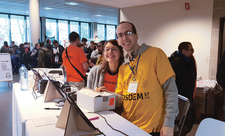FOSDEM 2017
Equilibrium

Long lines and interesting discussions awaited the visitor at this year's FOSDEM event in Brussels, Belgium.
Apparently, not even the FOSDEM team can guess which topics will attract a large audience and which will not, despite many years of experience. The result: Long lines formed before some rooms at FOSDEM'17, the largest European FOSS community event, which was held in early February 2017.
The fast campus LAN closed the breach for those waiting in line this time, however. The organizers broadcast live streams of presentations from all rooms by building their own content delivery network, proving that FOSDEM is in good shape in terms of hardware. Many of the videos are now online [1].
Buses and trains were running again, in contrast with the previous year, but visitors seem to like FOSDEM the way it is – including the beer event on the evening before the headliner. The organizers can only roughly estimate the number of visitors (about 8,000) because they do not sell tickets.
[...]
Buy this article as PDF
(incl. VAT)
Buy Linux Magazine
Subscribe to our Linux Newsletters
Find Linux and Open Source Jobs
Subscribe to our ADMIN Newsletters
Support Our Work
Linux Magazine content is made possible with support from readers like you. Please consider contributing when you’ve found an article to be beneficial.

News
-
Parrot OS Switches to KDE Plasma Desktop
Yet another distro is making the move to the KDE Plasma desktop.
-
TUXEDO Announces Gemini 17
TUXEDO Computers has released the fourth generation of its Gemini laptop with plenty of updates.
-
Two New Distros Adopt Enlightenment
MX Moksha and AV Linux 25 join ranks with Bodhi Linux and embrace the Enlightenment desktop.
-
Solus Linux 4.8 Removes Python 2
Solus Linux 4.8 has been released with the latest Linux kernel, updated desktops, and a key removal.
-
Zorin OS 18 Hits over a Million Downloads
If you doubt Linux isn't gaining popularity, you only have to look at Zorin OS's download numbers.
-
TUXEDO Computers Scraps Snapdragon X1E-Based Laptop
Due to issues with a Snapdragon CPU, TUXEDO Computers has cancelled its plans to release a laptop based on this elite hardware.
-
Debian Unleashes Debian Libre Live
Debian Libre Live keeps your machine free of proprietary software.
-
Valve Announces Pending Release of Steam Machine
Shout it to the heavens: Steam Machine, powered by Linux, is set to arrive in 2026.
-
Happy Birthday, ADMIN Magazine!
ADMIN is celebrating its 15th anniversary with issue #90.
-
Another Linux Malware Discovered
Russian hackers use Hyper-V to hide malware within Linux virtual machines.

